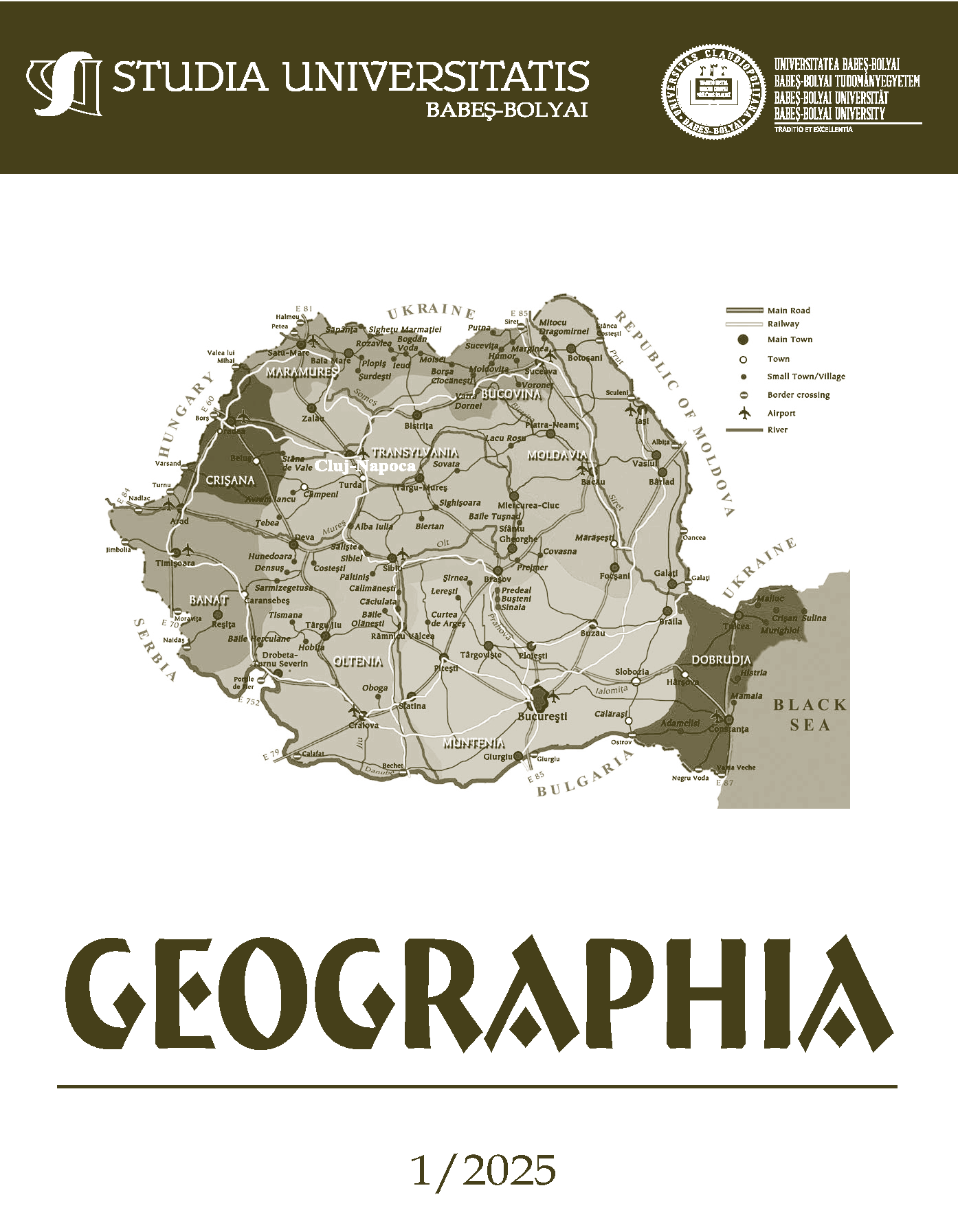The Tourist Accommodation Infrastructure in the Mountainous and Marginal Contact Area of Mureș County - The Decisive Factor for the Elaboration of Sustainable Tourism Strategies
DOI:
https://doi.org/10.24193/subbgeogr.2025.1.09Keywords:
Mureș County, mountain and marginal contact area, tourist infrastructure, accommodation unitsAbstract
The Tourist Accommodation Infrastructure in the Mountainous and Marginal Contact Area of Mureș County - the Decisive Factor for the Elaboration of Sustainable Tourism Strategies. The analysis of the tourist accommodation infrastructure of the mountainous and marginal contact area of Mureș County is part of a larger study on tourism in the area. This paper has analyzed statistical data on tourism structures with accommodation functions and their accommodation capacity in 2024 from a triple perspective: based on data provided by the National Institute of Statistics (INS), the Ministry of Economy, Entrepreneurship and Tourism (MEDAT) and, last but not least, data obtained through our own investigation. The purpose of this work is to provide a clear and close picture of the existing tourist accommodation units in the reference area so that the results obtained can be used to carry out the following sequences of the study and to foreshadow tourism development strategies in the area. As in the case of other economic activities, tourism has had periods of decline, stagnation, and positive evolution over the years, determined either by political, natural, social or economic causes.
References
1. Ciangă, N. (2007), România. Geografia turismului, Edit. Presa Universitară Clujeană, Cluj-Napoca.
2. Ciangă, N. and Dezsi, Şt. (2007), Amenajare turistică, Edit. Presa Universitară Clujeană, Cluj-Napoca.
3. Crăciun, A.M.; Dezsi, Ș.; Pop, F.; and Pintea, Cecilia (2022), Rural Tourism—Viable Alternatives for Preserving Local Specificity and Sustainable Socio-Economic Development: Case Study—”Valley of the Kings” (Gurghiului Valley, Mureș County, Romania). Sustainability 2022, 14, 16295
4. Cocean, P. and Dezsi, Şt. (2009), Geografia turismului, Edit. Presa Universitară Clujeană, Cluj-Napoca.
5. Consiliul Județean Mureș (2021), Planul de dezvoltare al județului Mureș 2021-2027, https://www.cjmures.ro/Programe_actiuni/PSDJ_Mures2021-2027_cu%20anexe_rev10.02.2022.pdf.
6. Dezsi, Şt. (2006a), Țara Lăpușului. Studiu de geografie regională, Edit. Presa Universitară Clujeană, Cluj-Napoca.
7. Dezsi, Şt. (2006b), Patrimoniu şi valorificare turistică, Edit. Presa Universitară Clujeană, Cluj-Napoca
8. Dezsi, Șt., Rusu, R., Ilieș, M., Ilieș, Gabriela, Bădărău, Al. S., and Roșian, Gh. (2014), The Role of Rural Tourism in the Social and Economic Revitalisation of Lăpuș Land (Maramureș County, Romania), 14th International Multidisciplinary Scientific Geoconference SGEM on Ecology, Economics, Education and Legislation, Conference Proceedings, volume II: Ecology & Environmental Protection, STEF92 Technology, Sofia, pp. 783-790, ISBN 978-619-7105-18-6, ISSN 1314-2704, DOI: 10.5593/sgem2014B52.
9. Gherman-Henning, Adriana (2017), The contribution of the local communities on the upper Mures Valley in the promotion of etnographic tourism by festivals, in Debating globalization. identity, nation and dialogue (Iulian Boldea, Cornel Sigmirean – eds.), section Social Sciences, pp. 318-323, https://old.upm.ro/gidni/GIDNI-04/Soc/Soc%2004%2044.pdf
10. National Tourism Authority (2013), Ordinul preşedintelui Autorităţii Naţionale pentru Turism nr. 65/2013 pentru aprobarea Normelor metodologice privind eliberarea certificatelor de clasificare a structurilor de primire turistice cu funcţiuni de cazare şi alimentaţie publică, a licenţelor şi brevetelor de turism.
11. Oltean, F.D. and Gabor, M.R. (2016), Service Diversification - a Qualitative and Quantitative Analysis in Mures County Hotels, Inzinerine Ekonomika-Engineering Economics 27, pp.618-628.
12. Primăria Sovata (2021), Strategia de dezvoltare locală a Orașului Sovata pentru perioada 2021 – 2027, https://primariasovata.ro/transparenta-decizionala/consultare-dezbatere-publica/strategia-de-dezvoltare-locala-a-orasului-sovata-pentru-perioada-2021-2027/
13. Răcăşan, Bianca-Sorina (2018), Turismul în spaţiul rural-montan şi de contact marginal din judeţul Cluj, Edit. Risoprint, Cluj-Napoca.
14. Romanian Government (1998), Ordonanţa Guvernului nr. 58/1998 privind organizarea şi desfăşurarea activităţii de turism în România, Monitorul Oficial no. 309 of 26 August 1998.
15. Rusu, R. (2022), The Impact of the COVID-19 Pandemic on Tourism in Romania in 2020 with Special Regard on Marginal Rural Areas, in Fuerst-Bjeliš, B., Nel, e., Pelc, S. (eds.) COVID-19 and Marginalisation of People and Places. Impacts, Responses and Observed Effects of COVID-19 on Geographical Marginality, Springer, in Perspectives on Geographical Marginality, Volume 7, Springer International Publishing, Switzerland, ISBN: 978-3-031-11138-9
16. Vasloban, Eva (2008), Sustainable development strategies in Mures County, in International Economic Conference on Integrative Relations between the European-Union-Institutions-and-the-Member-States, vol. 1, pp. 221-224.
17. http://statistici.insse.ro:8077/tempo-online/#/pages/tables/insse-table
18. https://turism.gov.ro/web/autorizare-turism/
19. https://legislatie.just.ro/Public/DetaliiDocument/148944.
Downloads
Published
How to Cite
Issue
Section
License
Copyright (c) 2025 Studia Universitatis Babeș-Bolyai Geographia

This work is licensed under a Creative Commons Attribution-NonCommercial-NoDerivatives 4.0 International License.


 ©Studia Universitatis Babeş-Bolyai Geographia. Published by Babeș-Bolyai University.
©Studia Universitatis Babeş-Bolyai Geographia. Published by Babeș-Bolyai University.